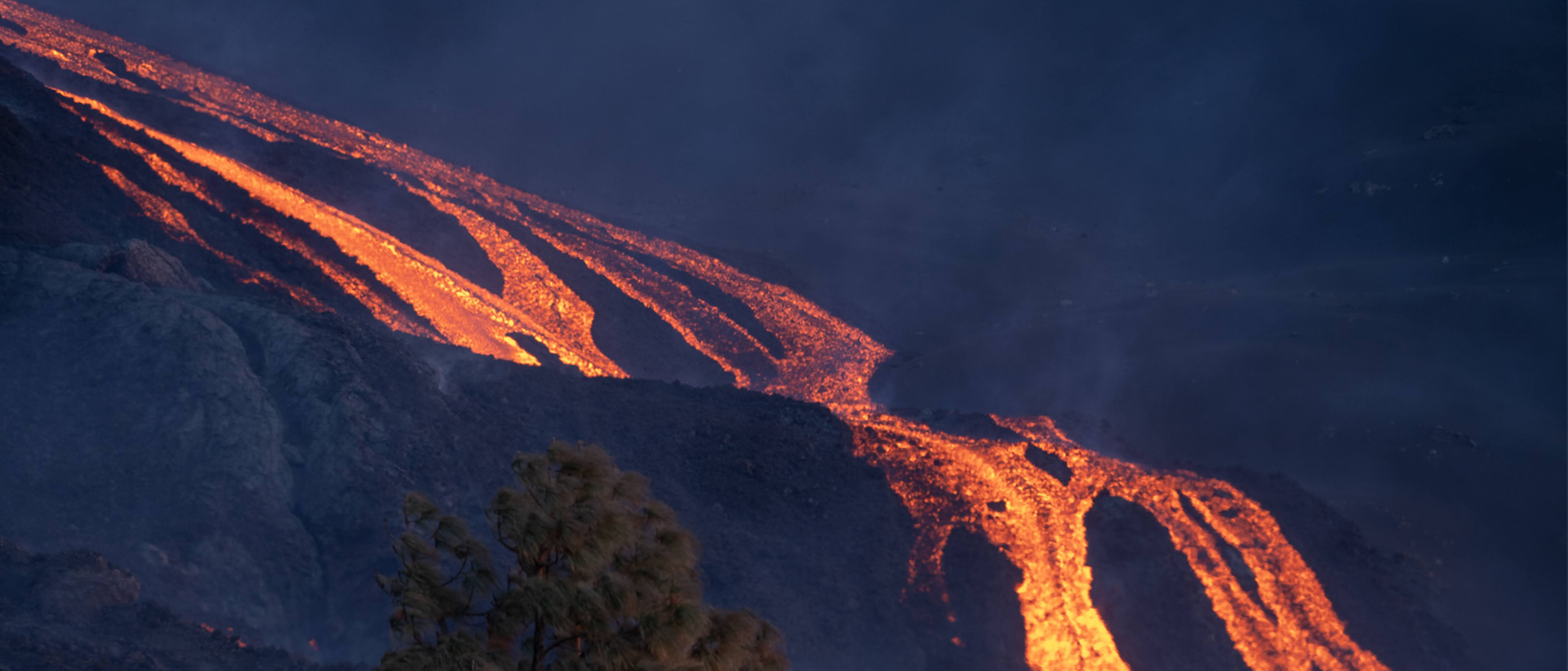Dual magma chambers under La Palma’s volcano

Fluid lava flows down the slope near the village of Tacande, La Palma, in early December 2021.
After 50 years of dormancy, the Cumbre Vieja (“Old Peak”) volcanic ridge on the Canary Island of La Palma burst into life in September 2021. Lava, ash and volcanic bombs were hurled from multiple cracks in the rock. The eruption has yielded new knowledge about how the Canary Islands’ volcanoes work.
“Volcanic eruptions are dramatic and don’t happen that often in the Canaries. On land, the last time was in 1971, when good equipment and as many instruments as today weren’t available to study it with. The frequency of eruptions there is about once every 50 years. So it’s a once-in-a-lifetime chance,” says Professor Valentin Troll of the Department of Earth Sciences, who studied the eruption in situ.
His research focuses on investigating the chemical composition of lava. The presence of various minerals can tell us a lot about where and how the lava was formed, the nature of the eruption and how powerful it was in its various phases.
“Chemically, lava changes during an eruption, and this can affect the eruption in such a way as to change its intensity. In the 1949 eruption, the lava composition became more similar to Earth’s mantle towards the end of the eruption, when the intensity decreased,” Troll says.
This time, too, the same pattern was seen, with the Cumbre Vieja eruption at its most intense initially and dying down somewhat as the lava became more mantle-like. Because of this, combined with the seismic measurements, Troll thinks it most likely that, under the volcano, there are two magma chambers that store magma (molten rock) before an eruption: a shallower one some 10 km deep and another further down, at a depth of about 30 km.
At the beginning of the eruption, the first magma reservoir was emptied. There, a relatively high water content had caused certain minerals to accumulate in the magma. As the upper magma chamber was emptied, more and more magma was pumped up from the lower reservoir, where the composition was more like Earth’s mantle. As long as some magma was left in the system, the eruption could continue, but no longer.
“One thing I found a bit surprising was that the volcano behaved a bit rhythmically. First, the eruption was intense and then weaker, then intense and weaker again. That was repeated four times,” Troll says.
With modelling, the scientists were able to see that this pattern was probably determined by pressure changes under the volcano, when magma was being pumped up from the lower to the upper magma chamber.
Tremors for several years
The eruption came as no surprise. For four years, the volcano had shown signs of increased activity in the form of tremors when the magma chambers were filling up. Seismic activity increased in the week before eruption. There was no doubt that something was happening, but where exactly along the 25-kilometre volcanic ridge the lava would force its way up was much more difficult to predict.
At 3:15 pm on 19 September 2021, the eruption began. Over the 85 days of its duration, about 3,000 buildings, 90 km of roads and a considerable area of agricultural land were devastated by the surging lava. By the time the volcano had calmed down again, La Palma had grown by 12.3 square kilometres and the researchers’ knowledge of the Canary Islands’ volcanism had grown.
“We’ve learnt several things. First and foremost, we can actually make use of previous eruptions. They generally end after three months. This one lasted 85 days, and it was the same type of eruption as those in La Palma in 1949 and Tenerife in 1909. Based on how lava and ash were deposited, we’re very confident that the next eruption in the Canaries will most likely be of the same type. And that means we can make good predictions,” Troll says.
Many eruptions recently
The eruption in La Palma was only one of many that were given extensive media coverage recently. Does this mean that volcanic eruptions have become more frequent? Having investigated the matter, Troll says no.
“What’s special now is that in the past year, we’ve had three major eruptions in Europe. Besides La Palma, they’ve occurred in Iceland and Etna in Italy. What’s different from before is that they get more attention. The media reports them and lots of people take film and pictures with their phones and post them on social media. Every year, between 400 and 500 volcanoes in the world erupt, and at any given moment there are 20 to 25 erupting.”
Åsa Malmberg
Why there are volcanoes in the Canary Islands
Volcanoes occur mainly where Earth’s continental plates are moving apart or colliding. However, there is another kind of volcanism found in places remote from the plate boundaries, where magma flows up towards Earth’s crust, creating “hot spots”. The most famous example is Hawaii, but the Canary Islands are another hot spot.
Magma or lava?
Magma arises when melting takes place in parts of Earth’s crust and/or its mantle, located between the crust and the core. Before a volcano erupts, magma is stored in a chamber beneath it. When the magma forces its way up to Earth’s surface it is known as lava, but if it is sprayed out under very high pressure and fragmented, volcanic ash is formed instead.
